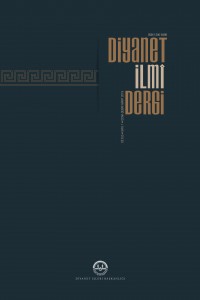Öz
There are certain values people have been regarding sacred throughout
history. They consist of signs and symbols triggering the same emotions and
thoughts in people of the same faith in the society. They become sacred under
the influence of customs and traditions as result of being transmitted from
generation to generation. The concept of sacredness can be defined as the complete set of values including worships and
rituals that establish, and remind, a connection between believers and the
transcendental Power (the Creator). Just as there are specific times and places
regarded sacred in Islam, there are also objects regarded sacred by the
followers of Islam. They are called kutsal emanet (sacred relics) in the
Turkish culture. Among them are the clothes and objects belonging to the Last
Prophet Muhammad and his family members and close people around them. One of
the most widely known of them is the string(s) of the Prophet Muhammad’s
beard/hair exhibited usually on sacred days and nights at mosques, which should
have a place in almost all our lives and the mystery of which we cannot
understand. Going to see and greet it been in practice promoted by foundations
as a good act. The tradition was seen for the first time in the charters of the
foundations built after the third quarter of the 18th century.
Anahtar Kelimeler
Foundation Sacred Relics Forgiveness String(s) of the Prophet Muhammad’s Beard
Kaynakça
- Arşiv Kaynakları-Vakıflar Genel Müdürlüğü Arşivi (VGMA)
- VGMA.570; VGMA.571; VGMA. 579; VGMA. 581/1; VGMA. 581/2; VGMA. 582/1; VGMA. 610; VGMA. 624; VGMA. 629; VGMA. 630/2; VGMA. 631; VGMA. 634; VGMA. 637; VGMA. 746; VGMA. Kasa:137.
- Atalar, Mustafa. Osmanlı Devletinde Surre-i Hümâyûn ve Surre Alayları. Ankara: 1999.
- Bozkurt, Nebi. “Mukaddes Emanetlerin Tarihi ve Osmanlı Devletine İntikâli”. Marmara İlahiyat Fakültesi Dergisi 15 (1997): 7-26.
- Bozkurt, Nebi. “Mukaddes Emanetler”. Türkiye Diyanet Vakfı İslâm Ansiklopedisi. 31:108-111. Ankara: TDV Yayınları, 2006.
- Bozkurt, Nebi. “Sakalı Şerif”. Türkiye Diyanet Vakfı İslâm Ansiklopedisi. 36:1-2. Ankara: TDV Yayınları, 2009.
- Küçükaşçı, Mustafa Sabri. “Mukaddes Emanetlerin Anlamı ve İstanbul’u Şereflendirmesine Dâir”, Keşkül Dergisi 31 (2014): 20-34.
- Polat, Mahir – Sevim, İrfan. “Türk İnşaat ve Sanat Eserleri Müzesi Koleksiyonunda Bulunan Sakal-ı şerif Muhafazlarının Restorasyonu, Restorasyon Yıllığı. 10 (2010) 121-126.
Öz
Tarih boyunca insanların kutsal kabul ettikleri
bazı değerler mevcuttur. Bunlar toplumdaki ortak inanca mensup bireylerde aynı
duygu ve düşünceleri uyandıran simgelerden ya da simgesel nesnelerden oluşur. Gelenek
ve göreneklerin de etkisiyle nesilden nesile aktarılarak kutsal bir anlam
kazanır. Kutsal kavramı doğaüstü yaratıcı güç ile
inananlar arasında bağlantıyı sağlayan, hatırlatan ibadet ve ritüelleri
kapsayan değerler bütünü olarak da tanımlanabilir. İslâm dininde kutsal kabul
edilen zamanlar ve mekânlar olduğu gibi bu dine mensup kişilerce kutsal kabul
edilen eşyalar da mevcuttur. Bunlar
kültürümüzde kutsal emanetler olarak
tanımlanırlar. Son peygamber Hz. Muhammed (s.a.s) ile onun aile efradı ve yakın
çevresine ait kıyafetler, eşyalar gibi bazı somut değerlerden oluşur. Halk
arasında en yaygın olarak bilineni, Hz. Muhammed’e ait saç veya sakallardan
olduğu kabul edilen mübarek gün ve gecelerde genellikle camilerde ziyaret
edilen sakal-ı şeriflerdir. Vakıflarca sakal-ı şerif/lihye-i şerif teberrük
etme ve ziyaret ettirilme şeklinde bir tür hayır hizmeti olarak
gerçekleştirilmiştir. Bu gelenek 18. yüzyılın üçüncü çeyreğinden sonra kurulan
vakıflara ait vakfiyelerde karşımıza çıkar.
Anahtar Kelimeler
Kaynakça
- Arşiv Kaynakları-Vakıflar Genel Müdürlüğü Arşivi (VGMA)
- VGMA.570; VGMA.571; VGMA. 579; VGMA. 581/1; VGMA. 581/2; VGMA. 582/1; VGMA. 610; VGMA. 624; VGMA. 629; VGMA. 630/2; VGMA. 631; VGMA. 634; VGMA. 637; VGMA. 746; VGMA. Kasa:137.
- Atalar, Mustafa. Osmanlı Devletinde Surre-i Hümâyûn ve Surre Alayları. Ankara: 1999.
- Bozkurt, Nebi. “Mukaddes Emanetlerin Tarihi ve Osmanlı Devletine İntikâli”. Marmara İlahiyat Fakültesi Dergisi 15 (1997): 7-26.
- Bozkurt, Nebi. “Mukaddes Emanetler”. Türkiye Diyanet Vakfı İslâm Ansiklopedisi. 31:108-111. Ankara: TDV Yayınları, 2006.
- Bozkurt, Nebi. “Sakalı Şerif”. Türkiye Diyanet Vakfı İslâm Ansiklopedisi. 36:1-2. Ankara: TDV Yayınları, 2009.
- Küçükaşçı, Mustafa Sabri. “Mukaddes Emanetlerin Anlamı ve İstanbul’u Şereflendirmesine Dâir”, Keşkül Dergisi 31 (2014): 20-34.
- Polat, Mahir – Sevim, İrfan. “Türk İnşaat ve Sanat Eserleri Müzesi Koleksiyonunda Bulunan Sakal-ı şerif Muhafazlarının Restorasyonu, Restorasyon Yıllığı. 10 (2010) 121-126.
Ayrıntılar
| Birincil Dil | Türkçe |
|---|---|
| Bölüm | Araştırma Makalesi |
| Yazarlar | |
| Yayımlanma Tarihi | 15 Mart 2019 |
| Gönderilme Tarihi | 20 Mart 2018 |
| Yayımlandığı Sayı | Yıl 2019 Cilt: 55 Sayı: 1 |


